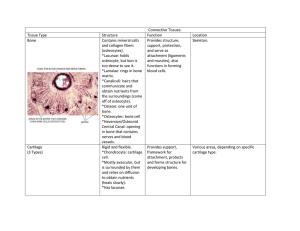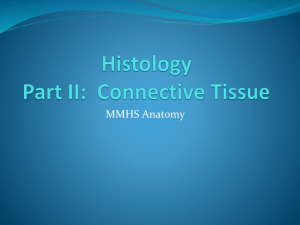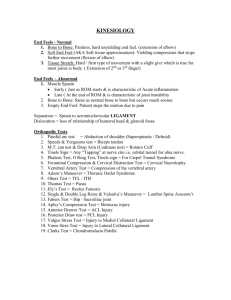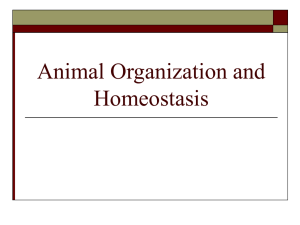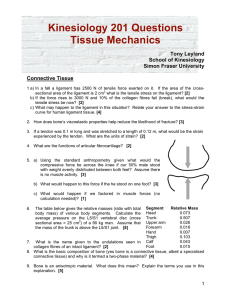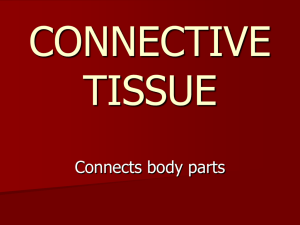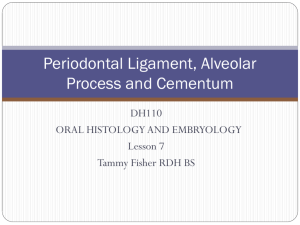3rd year periodontal ligament
advertisement
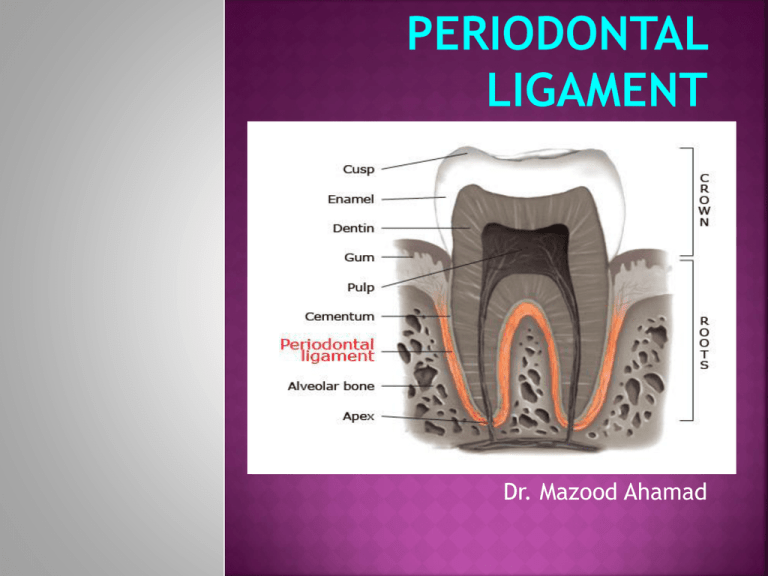
Dr. Mazood Ahamad The periodontal ligament is the connective tissue that surrounds the root and connects it with the bone. It is the soft richly vascular and cellular connective tissue which surround the tooth root and connects it to the inner wall of the alveolar bone. Average space or width: 0.25 mm (0.150.38 mm) They are divided into: A) The principal fibers. B) The accessory fibers. C) The oxytalan ( elastic ) fibers. The most important elements of the periodontal ligament are the principal fibers, are collagenous, are arranged in bundles, and follow a wavy course when( longitudinal sections) Terminal portions of the principal fibers that insert into cementum and bone are termed Sharpey's fibers Collagen Type 1 – Principal fibers Collagen type 3 – Reticular Fibers Collagen Type 4 Collagen is a protein composed of different amino acids, the most important are glycine, proline,hydroxylysine, and hydroxyproline. Collagen biosynthesis occurs inside the fibroblasts to form tropocollagen molecules. These aggregate into microfibrils that are packed together to form fibrils these fibrils associate to form fibers, the fibers associate to form bundles The principal fibers of the periodontal ligament are arranged in six groups 1-Transseptal or interdental ligament. 2- Alveolar crest group. 3- Horizontal group. 4- Oblique group. 5-Apical group. 6- Interradicular group. 1-Transseptal or interdental ligament Transseptal fibers extend interproximally over the alveolar bone crest and are embedded in the cementum of adjacent teeth Reconstructed even after destruction of the alveolar bone 2- Alveolar crest group. Alveolar crest fibers extend obliquely from the cementum just beneath the junctional epithelium to the alveolar crest. The alveolar crest fibers prevent the extrusion of the tooth and resist lateral tooth movements. 3- Horizontal group. Horizontal fibers extend at right angles to the long axis of the tooth from the cementum to the alveolar bone. 4- Oblique group. The largest group , extend from the cementum in a coronal direction obliquely to the bone They bear the brunt of vertical masticatory stresses and transform them into tension on the alveolar bone. 5-Apical group. Fibers radiate in a rather irregular fashion from the cementum to the bone at the apical region of the socket. They do not occur on incompletely formed roots. 6- Interradicular group. The Interradicular fibers fan out from the cementum to the tooth in the furcation areas of multirooted teeth. 1. 2. 3. 4. Four types of cells have been identified in the periodontal ligament: Connective tissue cells, Epithelial rest cells, Immune system cells, and Cells associated with neurovascular elements. fibroblast Synthetic cells cementoblast oseoblast osteoclast Resorptive cells Connective tissue cells fibroblast Epithelial cell rests Defense cells cementoclast macrophages Mast cells Neurovascular elements eosinophils They represent the remnants of epithelial root sheath. appear as either isolated clusters of cells or interlacing strands most numerous in the apical and cervical areas. Proliferate when stimulated It consists of two main components: GLYCOSAMINOGLYCANS,such as hyaluronic acid and proteoglycans,and GLYCOPROTEINS such as fibronectin and laminin. It also has a high water content (70%). CEMENTICLES The periodontal ligament also may contain calcified masses called cementicles, Cementicles may develop from calcified epithelial rests; FUNCTIONS OF PDL I. Physical. II. Formative & Remodelling. III. Nutritional. IV. Sensory. l. Provision of a soft tissue "casing" to protect the vessels and nerves from injury by mechanical forces 2. Transmission of occlusal forces to the bone 3. Attachment of the teeth to the bone 4. Maintenance of the gingival tissues in their proper relationship to the teeth. 5. Resistance to the impact of occlusal forces (shock absorption) SHOCK ABSORPTION – 3 THEORIES 1. Tensional Theory. 2. Viscoelastic Theory. 3. Thixotropic Gel Theory. TENSIONAL THEORY Force is applied to crown Principal fibers unfold and straightens Transmits forces to bone Elastic deformation of bony socket Alveolar bone reaches its limit Load is transmitted to basal bone VISCOELASTIC THEORY Controlled by fluid movement. Forces transmitted to tooth. Extracellular fluid - from foramina in cortical layer to marrow spaces Fiber bundle absorb slack and tighten Blood vessels stenosis Passages of blood filtrates into tissues THIXOTROPIC GEL THEORY Behavior of Thixotropic Gel. Physiologic response – changes in viscosity of biologic system. The pdl is constantly undergoing remodelling. PDL cells participate in formation and resorption. Rate of formation & differentiation of fibroblasts affects rate of collagen, cementum & bone. Cementoblasts and osteoblasts are essential in building up cementum and bone. NUTRITIONAL & SENSORY The periodontal ligament supplies nutrients to the cementum, bone, and gingiva by way of the blood vessels and lymphatic drainage. The periodontal ligament is capable of transmitting tactile, pressure, and pain sensations THANK YOU
